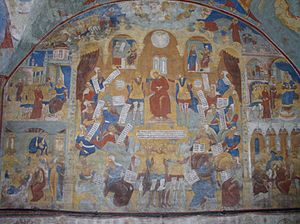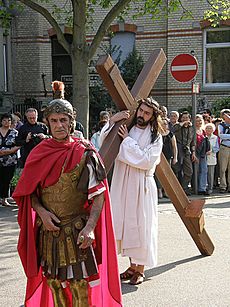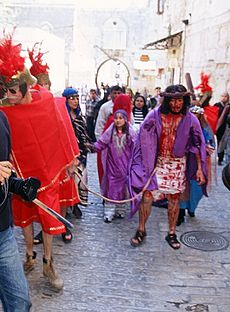Passion of Jesus facts for kids
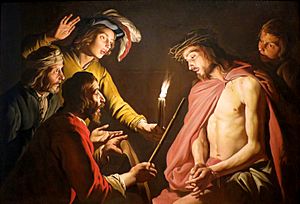
| Major events in Jesus's life in the Gospels |
|---|
|
The Passion (from the Latin word patior, meaning "to suffer" or "to endure") is the final period of Jesus Christ's life before his death. This important time is described in the four main canonical gospels of the Bible. Christians around the world remember these events every year during Holy Week.
The "Passion" includes many key moments. These are Jesus's triumphal entry into Jerusalem, when he rode into the city, and his cleansing of the Temple, where he cleared out merchants. It also covers his anointing, the Last Supper with his friends, his prayers in the Garden of Gethsemane, and his arrest. After his arrest, Jesus faced trials before Jewish leaders and before Pontius Pilate. Finally, it includes his crucifixion and death on the cross, and his burial. The parts of the Gospels that tell these stories are called the "Passion narratives." Some Christians also remember the sadness of Mary, the mother of Jesus, during this time.
The word passion can also mean the suffering and death of other Christian martyrs, who were people who died for their faith. Sometimes, the Latin word passio is used for this.
Contents
Stories from the Gospels
The stories of Jesus's Passion are found in the four main canonical gospels: Matthew, Mark, Luke, and John. Matthew, Mark, and Luke are called the Synoptic Gospels because their accounts are very similar. The Gospel of John tells the story with some important differences.
Scholars sometimes disagree on exactly which events are part of the "Passion narrative." Some say it starts after Jesus's arrest and ends before his resurrection. Others include events like Jesus's entry into Jerusalem, the Last Supper, his trial, crucifixion, burial, and even his resurrection as part of "Passion Week."
Main Events of the Passion
Here are the main events that are often included in the story of the Passion:
- Triumphal entry into Jerusalem: Many people welcomed Jesus when he arrived in Jerusalem.
- The Cleansing of the Temple: Jesus drove out animal sellers and money-changers from the Temple in Jerusalem.
- The Anointing of Jesus: A woman poured special oil on Jesus during a meal. Jesus said she would always be remembered for this.
- The Last Supper: Jesus shared a final meal with his disciples in Jerusalem. He gave them last instructions, said someone would betray him, and told them to remember him.
- Jesus predicts the Denial of Peter: After the meal, Jesus told his disciples they would all abandon him that night. When Peter said he wouldn't, Jesus said Peter would deny knowing him three times before a rooster crowed.
- The Agony in the Garden: Later that night, in Gethsemane, Jesus prayed while his disciples rested. Some old writings say Jesus was very scared and sweated blood, but this part is not in all versions of the Gospels.
- The Arrest of Jesus: Judas Iscariot led soldiers and officials to arrest Jesus. All his disciples ran away. During the arrest, someone (Peter, according to John) cut off the ear of a high priest's servant named Malchus.
- The Sanhedrin trial of Jesus: Jesus was taken to the Sanhedrin (the Jewish high court) that night. He was questioned and, according to some Gospels, beaten. The court decided he deserved to die. They then sent him to Pontius Pilate.
- The Denial of Peter: While Jesus was on trial, Peter was outside in the courtyard. People suspected he was with Jesus, so Peter denied knowing Jesus three times. Just then, a rooster crowed, and Peter remembered Jesus's words.
- Pilate's trial of Jesus: Early in the morning, Pontius Pilate, the Roman governor, questioned Jesus. Pilate found no fault in Jesus, but the Jewish leaders and the crowd demanded Jesus's death. Pilate offered to release Barabbas, a criminal, or Jesus. The crowd chose Barabbas. Pilate then sent Jesus to be crucified.
- The Way of the Cross: Jesus and two other prisoners were forced to walk to the place where they would be executed. Some Gospels say Simon of Cyrene carried Jesus's cross, while John says Jesus carried it himself.
- The Crucifixion of Jesus: Jesus and the two other prisoners were nailed to crosses at Golgotha, a hill outside Jerusalem. This happened from morning to mid-afternoon. Jesus spoke several times from the cross before he died.
- The Burial of Jesus: Jesus's body was taken down from the cross and placed in a tomb by Joseph of Arimathea (and Nicodemus according to John).
- The Resurrection of Jesus: Jesus rose from the dead, leaving behind an empty tomb. He reportedly appeared to many of his followers.
Gospel Differences
The Gospel of Luke says that Pilate sent Jesus to be judged by Herod Antipas because Jesus was from Galilee, which was Herod's area. Herod was excited to see Jesus and hoped for a miracle, but Jesus didn't answer his questions. Herod then mocked Jesus, dressed him in a fancy robe, and sent him back to Pilate.
All the Gospels say that Pilate released a man named Barabbas instead of Jesus. Matthew, Mark, and John say Pilate offered the crowd a choice. Luke says the crowd simply demanded Barabbas's release.
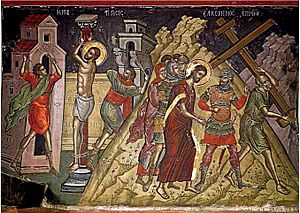
In all Gospels, Pilate asked Jesus if he was the King of the Jews, and Jesus replied, "So you say." After being condemned, Jesus was whipped before his execution. Matthew and Mark say soldiers took Jesus to the Praetorium, put a purple robe on him, a crown of thorns on his head, and a stick in his hand. They mocked him by calling him "King of the Jews" and hitting him.
According to the Gospel of John, Pilate showed Jesus to the crowd again, wearing the purple robe and crown of thorns, saying Ecce homo, which means "Behold the man." But the priests made the crowd demand Jesus's death. Pilate then washed his hands (according to Matthew) to show he was not responsible for Jesus's death. Matthew's Gospel says the crowd replied, "His blood be on us and on our children!"
Mark and Matthew say Jesus was given his own clothes back before being led away. He was forced to carry his own cross to Golgotha. The three Synoptic Gospels mention Simon of Cyrene being forced to carry the cross (Mark 15:21, Matthew 27:32, Luke 23:26). John (19:17) says Jesus carried his own cross.
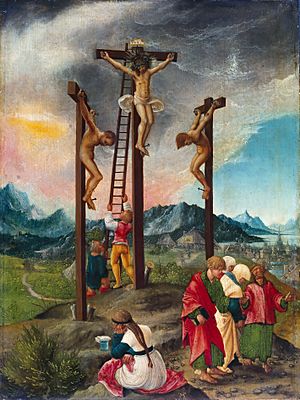
The Synoptic Gospels say that at Golgotha, Jesus was offered wine mixed with myrrh to ease the pain, but he refused it. Jesus was then crucified. Mark says it was at "the third hour" (9 a.m.), while John says it was "the sixth hour" (noon). Many believe this difference is because they used different ways of telling time. Pilate put a sign on Jesus's cross that said, Iesus Nazarenus Rex Iudeorum, meaning Jesus of Nazareth, King of the Jews. Soldiers divided Jesus's clothes among themselves, but for one garment, they cast lots (rolled dice). John says this fulfilled a prophecy from Psalms 22:18. Some people in the crowd taunted Jesus, saying, "He trusts in God; let God deliver him now!"
Two thieves were also crucified with Jesus, one on each side. Luke says one thief insulted Jesus, but the other said Jesus was innocent and asked to be remembered by Jesus (see Penitent thief).
John says Mary, Jesus's mother, and two other women stood by the cross, as did a disciple called the one whom Jesus loved. Jesus asked this disciple to care for his mother. The Synoptic Gospels say the sky became dark at midday for three hours. At the ninth hour, Jesus cried out, Eloi, Eloi, lama sabachthani? ("My God, my God, why have you forsaken me?"). The Roman soldier guarding him declared Jesus innocent (Luke) or the "Son of God" (Matthew, Mark).
John says soldiers broke the legs of the thieves to make them die faster, but when they came to Jesus, he was already dead. A soldier pierced his side with a spear.
According to Matthew, Judas, who betrayed Jesus, felt terrible and tried to return the money. When the high priests refused it, Judas threw the money into the Temple and then went and hanged himself. However, the Book of Acts (1:18) says Judas bought a field with the money, then fell and died there.
The Gospel of Peter's Story
Other early writings also tell about the Passion. One is the Gospel of Peter, which was found in Egypt in 1884.
This story starts with Pilate washing his hands, like in Matthew, but the Jewish leaders and Herod refuse to accept it. Joseph of Arimathea asks for Jesus's body before he is crucified. Herod then gives Jesus to the people, who drag him, dress him in a purple robe, crown him with thorns, and beat him.
Two criminals are also crucified with Jesus, and one asks for forgiveness, similar to Luke's Gospel. The writer says Jesus was silent during the crucifixion, "as if in no pain." Jesus is called the King of Israel on his cross, and his clothes are divided by gambling.
Like in the main Gospels, darkness covers the land. Jesus is also given vinegar to drink. The Gospel of Peter says Jesus's last words were "My Power, My Power, why have you forsaken me?" instead of "My God, My God, why have you forsaken me?" He is then "taken up," which might mean he died or went to heaven. This Gospel also describes a resurrection.
Jesus's Trials
The Gospels describe Jesus's trials differently. Mark tells of two separate trials: one with Jewish leaders and one with the Roman governor, Pontius Pilate. Matthew and John generally agree with Mark's two-trial version. Luke is the only Gospel that adds a third trial, where Pilate sends Jesus to Herod Antipas. The Gospel of Peter describes one trial involving Jewish, Roman, and Herodian officials.
Old Testament Prophecies
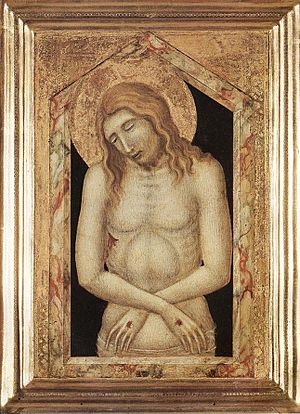
Christians believe that several parts of the Old Testament are prophecies about Jesus’s Passion.
One important prophecy is from Isaiah 52:13–53:12. This ancient message describes a perfect man who would suffer for the sins of his people. Through his suffering, he would save sinners from God's punishment. Christians believe Jesus's death fulfilled this prophecy. For example, it says: "He was despised and rejected by men; a man of sorrows, and familiar with suffering... But he was wounded for our wrongdoings, he was crushed for our sins; the punishment that brought us peace was on him, and by his wounds we are healed" (53:2–5).
Another prophecy Jesus himself quoted while dying on the cross is from HE. From the cross, Jesus cried, "Eli, Eli, lema sabachthani?" meaning, "My God, my God, why have you forsaken me?" In Psalm 22, King David described the sufferings of the Messiah. For example, "All who see me mock me... They divide my clothes among them and cast lots for my garment" (Psalm 22:7–19).
A third prophecy is from the Book of the Wisdom of Solomon. This book was written around 150 BC. Many people see verses 12–20 of chapter 2 as a direct prophecy of Jesus’s Passion. It says: "Let us lie in wait for the just, because he is not for our turn... Let us examine him by outrages and tortures... Let us condemn him to a most shameful death" (Wisdom 2:12–20).
Other Old Testament passages also describe events that happened during Jesus's crucifixion:
- "He guards all his bones: not one of them will be broken" (Psalm 34:20).
- "They gave me gall for my food, and in my thirst they gave me vinegar to drink" (Psalm 69:21).
- "They will look on me, the one they have pierced" (Zechariah 12:10).
New Testament Prophecy
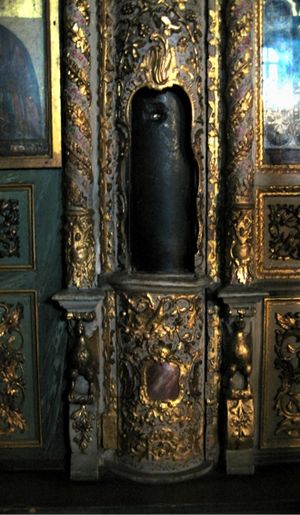
The Gospel of John explains how these old prophecies were fulfilled: "So the soldiers came and broke the legs of the first, and of the other who had been crucified with Jesus; but when they came to Jesus and saw that he was already dead, they did not break his legs. But one of the soldiers pierced his side with a spear... For these things took place that the scripture might be fulfilled, ‘Not a bone of him shall be broken.’ And again another scripture says, ‘They shall look on him whom they have pierced’" (John 19:32–37).
In the Gospel of Mark, Jesus is said to have predicted his own Passion and Resurrection three times:
- On the way to Caesarea Philippi, he said the Son of Man would be killed and rise in three days.
- After his transfiguration of Jesus, he again said the Son of Man would be killed and rise in three days.
- On the way to Jerusalem, he predicted he would be handed over, condemned to death, mocked, whipped, killed, and rise in three days.
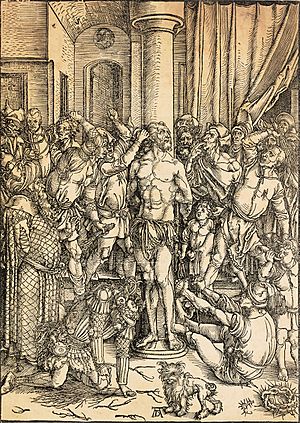
After the third prediction, the Gospel of Mark says that the brothers James and John asked Jesus for special places next to him. Jesus asked if they could drink from the "cup" he had to drink from. They said yes. Jesus confirmed this, but said those places were for others. Many Christians see this "cup" as a symbol of his death.
How the Passion is Remembered
Most Christian churches read stories of the Passion during Holy Week, especially on Good Friday. In the Roman Rite of the Catholic Church, a large cross is brought out for people to show respect. Instead of just the priest reading, whole groups of people often take part in reading the Passion Gospel during Palm Sunday Mass and the Good Friday service. The priest reads Jesus's part, a narrator reads the story, other readers take other speaking parts, and the choir or congregation reads the parts of crowds (like when they shout "Crucify Him!").
In the Byzantine Rite (Eastern Orthodox and Greek-Catholic Churches), the service for Good Friday morning is called Matins of the Twelve Passion Gospels. During this service, twelve readings from the Gospel Book are read, telling the events of the Passion in order, from the Last Supper to the burial. The first of these readings is the longest Gospel reading of the whole year. Also, every Wednesday and Friday throughout the year, the Passion is remembered.
During Holy Week, some churches like the Moravian Church read the entire story of Jesus's final week from a special book. They hold daily meetings, sometimes two or three times a day, to follow the events. As they read, the group sings hymns that relate to the story.
Most churches hold some kind of service remembering the Crucifixion on Good Friday afternoon. This might be a vigil from noon to 3:00 pm, which is about how long Jesus was on the cross. Sometimes, there is a re-enactment of the Descent from the Cross, like in the Byzantine tradition.

Special Prayers and Practices
Many special prayers and practices have been created by Christians to remember the Passion.
The Stations of the Cross
The Stations of the Cross are a series of religious reflections that show or describe Jesus carrying the cross to his crucifixion. Most Catholic churches, and many Anglican, Lutheran, and Methodist churches, have Stations of the Cross. These are usually small pictures or carvings placed along the walls of the church. The tradition of moving around these Stations to remember Jesus's Passion started with Francis of Assisi and spread throughout the Catholic Church. It is most often done during Lent, especially on Good Friday, but can be done on other days too.
The Little Office of the Passion
Another special prayer is the Little Office of the Passion, created by Francis of Assisi (1181/82–1226). He linked five specific moments in Jesus's Passion to certain times of the day, similar to how monks pray at different hours.
- Evening Prayer (Compline) – 9:00 PM – Jesus's Arrest on the Mount of Olives.
- Night Prayer (Matins) – 12:00 AM – Jesus's Trial before the Jewish Sanhedrin.
- Morning Prayer (Prime) – 6:00 AM – A celebration of Christ as the light of the new day.
- Mid-morning Prayer (Terce) – 9:00 AM – Jesus's Trial before Pontius Pilate.
- Midday Prayer (Sext) – 12:00 PM – Jesus's Crucifixion.
- Mid-afternoon Prayer (None) – 3:00 PM – Jesus's Death.
- Evening Prayer (Vespers) – 6:00 PM – Remembering the whole day's events.
The Passion in Art
Visual Art

Each event of the Passion, like the Flagellation of Christ (whipping) or Entombment of Christ (burial), has been shown many times in art. The Crucifixion is the most common and important of these. The Passion is often shown in a series of pictures or sculptures. Albrecht Dürer made several popular print series about the Passion. Andachtsbilder are special devotional artworks, like the Man of Sorrows or Pietà, that show Jesus's suffering. The Arma Christi, or "Instruments of the Passion," are the objects linked to Jesus's Passion, such as the cross, the Crown of Thorns, and the Spear. Many of these are believed to be relics and are shown in art. Veronica's Veil is also often included; it is a cloth believed to have touched Jesus's face.
In the Catholic Church, the Passion story is shown in the Stations of the Cross (via crucis, or "Way of the Cross"). These 14 stations show the Passion from Jesus being sentenced by Pilate to his tomb being sealed. Sometimes a 15th station, the resurrection, is added. Since the 16th century, these stations have decorated most Catholic churches. The Way of the Cross is a devotion practiced by many people on Fridays, especially on Good Friday. This can be done by walking around the Stations in a church, or by large re-enactments, like in Jerusalem.
Music
Special church music sung during Holy Week often includes Passions, which are musical versions of the Gospel stories. This is a tradition in both Catholic and Lutheran churches. Many musical pieces are also based on the Lamentations of Jeremiah the Prophet or the Stabat Mater, which is about Mary's sorrow.
Reading the Passion story from the Gospels during Holy Week dates back to the 4th century. By the 13th century, different singers would take on the roles of different characters in the story.
In the 17th century, longer musical works called oratorio passions developed. These led to Johann Sebastian Bach's famous Passions, which are accompanied by instruments and include other texts and songs. His St John Passion and St Matthew Passion are well-known examples.
In the 19th century, Passion music was less popular, but it became popular again in the 20th century. Examples include the St. Luke Passion (1965) by Krzysztof Penderecki and Passio (1982) by Arvo Pärt. Modern musical works like Jesus Christ Superstar and Godspell also include parts of the traditional Passion stories.
Drama and Processions
Non-musical plays about the Passion story are called Passion plays. These have been performed widely in Catholic countries, often in churches. A famous Passion play is performed every ten years in Oberammergau, Germany. Another important one is in Sordevolo, Italy. In the Brazilian state of Pernambuco, a large open-air theater is used for a Passion play.
Processions on Palm Sunday often re-enact Jesus's entry into Jerusalem, sometimes using special wooden donkeys on wheels. Holy Week in Spain has many traditional public processions, with the most famous ones in Seville. These feature large floats with carved scenes from the Passion story.
Other Traditions
- The sons of Simon of Cyrene are named in Mark's Gospel as if they were known to early Christians. Paul also mentions a Rufus in Romans 16:13.
- Jesus's "seamless robe" was likely made of special cloth from Bethlehem or Damascus, as most clothes of that time were made of narrow woven strips.
- A tradition says that Saint Veronica was a kind woman in Jerusalem who gave Jesus her handkerchief to wipe his forehead. When he gave it back, his face was miraculously printed on it.
The Passion of Jesus in Plants
The tropical plant passiflora, also known as the passion flower, was brought to Europe in the 16th century. A Jesuit priest named F B Ferrari named it because he saw parts of the flower as symbols of the instruments of Christ's Passion. For example, the three stigmas represent three nails, a circle of filaments looks like a bloody crown of thorns, and the five anthers represent the five wounds of Jesus. The tendrils are seen as the whips used in the flagellation of Christ, and the white color symbolizes Jesus's innocence.
Images for kids
-
Russian Orthodox icon of the Passion with scenes of the martyrdom of the Twelve Apostles.
See also
 In Spanish: Pasión de Cristo para niños
In Spanish: Pasión de Cristo para niños
- Acts of Reparation to Jesus Christ
- Jesus at Herod's court
- Life of Jesus in the New Testament
- Passion cantata
- Sacri Monti of Piedmont and Lombardy
- Instruments of the Passion
- Christian tragedy


